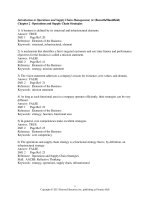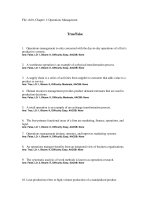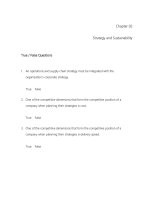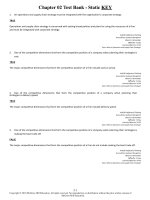Introduction to operations and supply chain management 3e bozarth chapter 05
Bạn đang xem bản rút gọn của tài liệu. Xem và tải ngay bản đầy đủ của tài liệu tại đây (545.47 KB, 40 trang )
Managing Quality
Chapter 5
Chapter Objectives
Be able to:
Discuss the various definitions and dimensions of quality and
why quality is important to operations and supply chains.
Describe the different costs of quality, including internal and
external failure, appraisal, and prevention costs.
Describe what TQM is, along with its seven core principles.
Calculate process capability ratios and indices and set up
control charts for monitoring continuous variables and
attributes.
Describe the key issues associated with acceptance sampling, as
well as the use of OC curves.
Distinguish between Taguchi’s quality loss function and the
traditional view of quality.
Copyright © 2013 Pearson Education, Inc. publishing as Prentice Hall
5-2
Quality Defined
Quality – The characteristics of a product or service
that bear on its ability to satisfy stated or implied
needs; a product or service that is free of
deficiencies.
Value perspective – A quality perspective that holds that
quality must be judged, in part, by how well the
characteristics of a particular product or service align with
the needs of a specific user.
Conformance perspective – A quality perspective focused
on whether or not a product was made or a service was
performed as intended.
Copyright © 2013 Pearson Education, Inc. publishing as Prentice Hall
5-3
Eight Dimensions of Quality
Performance
Features
Reliability
Durability
Conformance
Aesthetics
Serviceability
Perceived Quality
Copyright © 2013 Pearson Education, Inc. publishing as Prentice Hall
5-4
Quality Dimension Examples
Table 5.1
Copyright © 2013 Pearson Education, Inc. publishing as Prentice Hall
5-5
Total Cost of Quality
Prevention costs – Costs an organization incurs to
actually prevent defects from occurring to begin
with.
Appraisal costs – Costs a company incurs for
assessing its quality levels.
Internal failure costs – Costs caused by defects that
occur prior to delivery to the customer.
External failure costs – Costs incurred by defects that
are not detected until a product or service reaches
the customer.
Copyright © 2013 Pearson Education, Inc. publishing as Prentice Hall
5-6
Total Cost of Quality
Traditional View
Figure 5.2
Copyright © 2013 Pearson Education, Inc. publishing as Prentice Hall
5-7
Total Cost of Quality
Zero Defects View
Figure 5.3
Copyright © 2013 Pearson Education, Inc. publishing as Prentice Hall
5-8
Total Quality Management
Total Quality Management A managerial approach in which an
organization is managed so that it excels in all
quality dimensions that are important to
customers.
Copyright © 2013 Pearson Education, Inc. publishing as Prentice Hall
5-9
Total Quality Management
Customer focus
Leadership involvement
Continuous improvement
Employee empowerment
Quality assurance
Strategic partnerships
Strategic quality plan
Copyright © 2013 Pearson Education, Inc. publishing as Prentice Hall
5 - 10
Total Quality Management
Customer focus
Each employee has a customer whether internal
or external to the company.
Leadership involvement
Must be ‘top’ down, throughout the company.
If not, major cause of TQM failures.
Continuous improvement
There is always room for improvement.
Copyright © 2013 Pearson Education, Inc. publishing as Prentice Hall
5 - 11
Total Quality Management
Employee empowerment
Giving employees the responsibility for managing quality.
Quality assurance
Quality Function Deployment (QFD) discussed in Chapter
15
Statistical quality control (SQC), also called statistical
process control (SPC)
Copyright © 2013 Pearson Education, Inc. publishing as Prentice Hall
5 - 12
Total Quality Management
Supplier Partnerships
The commitment between firms and supply chain
partners must be the same.
Strategic Quality Plan
Sets a broad set of objectives.
Should establish measurable goals for the shortterm.
Copyright © 2013 Pearson Education, Inc. publishing as Prentice Hall
5 - 13
Process Capability
Answers the Question:
Can the process provide
acceptable quality consistently?
Copyright © 2013 Pearson Education, Inc. publishing as Prentice Hall
5 - 14
Process Capability Ratio (Cp)
Process Capability Ratio (Cp) – Measures whether or not a process is potentially capable of
meeting certain quality standards
Cp =
Upper Tolerance Limit – Lower Tolerance Limit
6σ
Where σ is the estimated
standard deviation
for the individual observations
Copyright © 2013 Pearson Education, Inc. publishing as Prentice Hall
5 - 15
Normal Distribution
Figure 5.4
Copyright © 2013 Pearson Education, Inc. publishing as Prentice Hall
5 - 16
Process Capability Values
Figure 5.5
Copyright © 2013 Pearson Education, Inc. publishing as Prentice Hall
5 - 17
Process Capability Index
Process Capability Index (Cpk) – Measures whether or not a process is capable of
meeting certain quality standards and is centered between the specification limits.
LTL UTL
Cpk min
,
3
3
Copyright © 2013 Pearson Education, Inc. publishing as Prentice Hall
5 - 18
Six Sigma Quality
To achieve Six Sigma quality, the variability
of a process must be reduced to the point
that the process capability ratio is greater
than or equal to 2.
Copyright © 2013 Pearson Education, Inc. publishing as Prentice Hall
5 - 19
Six Sigma Quality
Figure 5.6
Copyright © 2013 Pearson Education, Inc. publishing as Prentice Hall
5 - 20
Control Charts
Control Chart – A specialized run chart that
helps an organization track changes in key
measures over time.
Continuous variable – A variable that can be
measured along a continuous scale.
Attribute – The presence or absence of a
particular characteristic.
Copyright © 2013 Pearson Education, Inc. publishing as Prentice Hall
5 - 21
Sampling
Sampling – Using carefully selected samples
to get a fairly good idea of how well a process
is working.
Good sample:
Every outcome has an equal chance of being
selected into the sample.
The sample size is large enough to not be swayed
by any single observation.
Copyright © 2013 Pearson Education, Inc. publishing as Prentice Hall
5 - 22
Continuous Variable
Measurements
Copyright © 2013 Pearson Education, Inc. publishing as Prentice Hall
5 - 23
Control Charts
X chart - A specific type of control chart for a
continuous variable that is used to track the average
value for future samples.
R chart – A specific type of control chart for a
continuous variable that is used to track how much
the individual observations within each sample
vary.
p chart – A specific type of control chart for
attributes that is used to track sample proportions.
Copyright © 2013 Pearson Education, Inc. publishing as Prentice Hall
5 - 24
Step 1 – Sampling the Process
Observation
Sample
1
2
3
4
5
1
136
137
144
141
138
2
143
138
140
140
139
3
140
141
144
137
135
4
139
140
141
139
141
5
137
138
143
140
138
6
142
141
140
139
138
7
143
141
143
140
140
8
139
139
141
140
136
9
140
138
143
141
139
10
139
141
142
140
136
Copyright © 2013 Pearson Education, Inc. publishing as Prentice Hall
5 - 25









